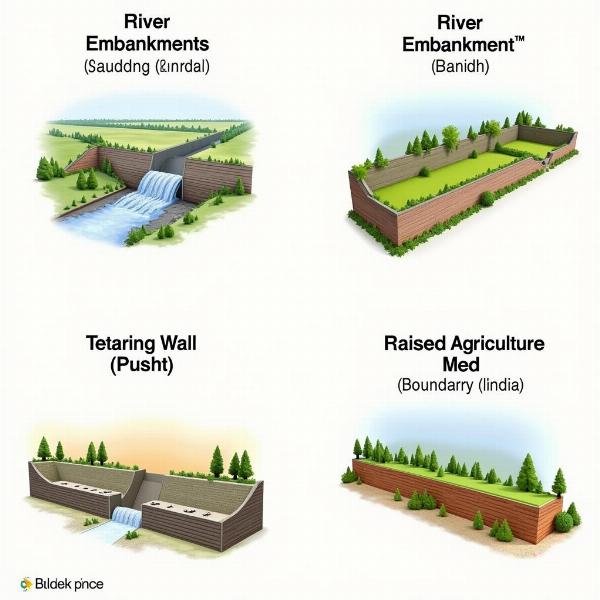Understanding the meaning of “embankment” in Hindi is crucial for various contexts, from engineering and construction to everyday conversations. This article explores the different Hindi translations of “embankment,” their nuances, and their usage in various scenarios. It also delves into related terms and phrases to provide a comprehensive understanding of this important concept.
Understanding the Core Meaning of Embankment
“Embankment” essentially refers to a raised structure, often made of earth, rock, or concrete, built to contain water, support a roadway, or protect against flooding. Its primary purpose is to provide a barrier or support. This core meaning is reflected in its Hindi translations.
Common Hindi Translations of Embankment
The most common Hindi translations of “embankment” include:
- बाँध (Bandh): This is perhaps the most frequent and versatile translation. It generally refers to a dam or a structure built to hold back water.
- तटबंध (Tatbandh): This term specifically denotes an embankment built along a river or coast to prevent flooding.
- पुश्त (Pusht): This word often implies support or backing. In the context of an embankment, it refers to a structure providing support or reinforcement, like a retaining wall.
- मेड़ (Med): This term generally refers to a raised ridge or boundary, often used in agricultural contexts.
Which Hindi Word to Use and When?
The choice of the appropriate Hindi word for “embankment” depends on the specific context. If you are discussing a large dam, बाँध (Bandh) is the most suitable term. For coastal protection or river control, तटबंध (Tatbandh) is more specific. When referring to a supporting structure, पुश्त (Pusht) is appropriate. And for a simple raised boundary, मेड़ (Med) is often used.
 Types of Embankments in India
Types of Embankments in India
Embankment in Different Contexts
The word “embankment” takes on different connotations depending on the field in which it is used:
- Engineering: In engineering, “embankment” often refers to a specifically designed structure for road or rail support, flood control, or water retention.
- Construction: In construction, it may refer to the process of creating such a structure or the structure itself.
- Geography: In geography, “embankment” often describes natural formations like riverbanks or levees.
What is the purpose of an embankment?
Embankments serve several critical functions:
- Flood Control: Protecting land and property from flooding.
- Water Storage: Creating reservoirs for irrigation and water supply.
- Transportation: Providing stable foundations for roads and railways.
- Erosion Control: Preventing soil erosion and land degradation.
How are embankments constructed?
Embankment construction involves careful planning and execution:
- Site Selection: Choosing a suitable location based on soil type and topography.
- Material Selection: Selecting appropriate materials like earth, rock, or concrete.
- Compaction: Compacting the materials to create a stable structure.
- Drainage: Incorporating drainage systems to prevent water buildup.
Expert Insights on Embankments
According to Dr. Anjali Sharma, a renowned civil engineer in India, “Properly constructed embankments are vital for infrastructure development and disaster management. They require careful consideration of soil mechanics, hydrology, and environmental factors.”
Another expert, Mr. Rohan Verma, a geotechnical engineer, adds, “Embankment stability is crucial, and regular monitoring is essential to ensure long-term performance and prevent failures.”
Conclusion
Understanding the meaning of “embankment” in Hindi requires considering the context and the specific nuance you wish to convey. Whether you use बाँध (Bandh), तटबंध (Tatbandh), पुश्त (Pusht), or मेड़ (Med), choosing the correct term ensures accurate and effective communication. Embankments play a crucial role in various aspects of life in India, from water management and flood control to infrastructure development and agriculture.
FAQ
- What is the most common Hindi word for embankment? बाँध (Bandh) is the most commonly used word.
- What does तटबंध (Tatbandh) specifically refer to? It refers to an embankment built along a river or coast to prevent flooding.
- What is the meaning of पुश्त (Pusht) in the context of embankments? It refers to a supporting structure, like a retaining wall.
- What does मेड़ (Med) mean? It generally refers to a raised ridge or boundary, often used in agricultural contexts.
- Why are embankments important? They are crucial for flood control, water storage, transportation, and erosion control.
- How are embankments constructed? The process involves site selection, material selection, compaction, and drainage.
- What factors should be considered during embankment construction? Soil mechanics, hydrology, and environmental factors are crucial.
Meaning-Hindi.in provides expert translation services in Hindi and various other languages, specializing in business, legal, technical, website, educational, and specialized translation. We offer accurate and culturally sensitive translations to bridge the communication gap between languages and cultures. Whether you need document translation, website localization, or interpretation services, our team of experienced linguists ensures high-quality and reliable results. Contact us today at [email protected] or call us at +91 11-4502-7584. Let Meaning-Hindi.in be your trusted language partner!